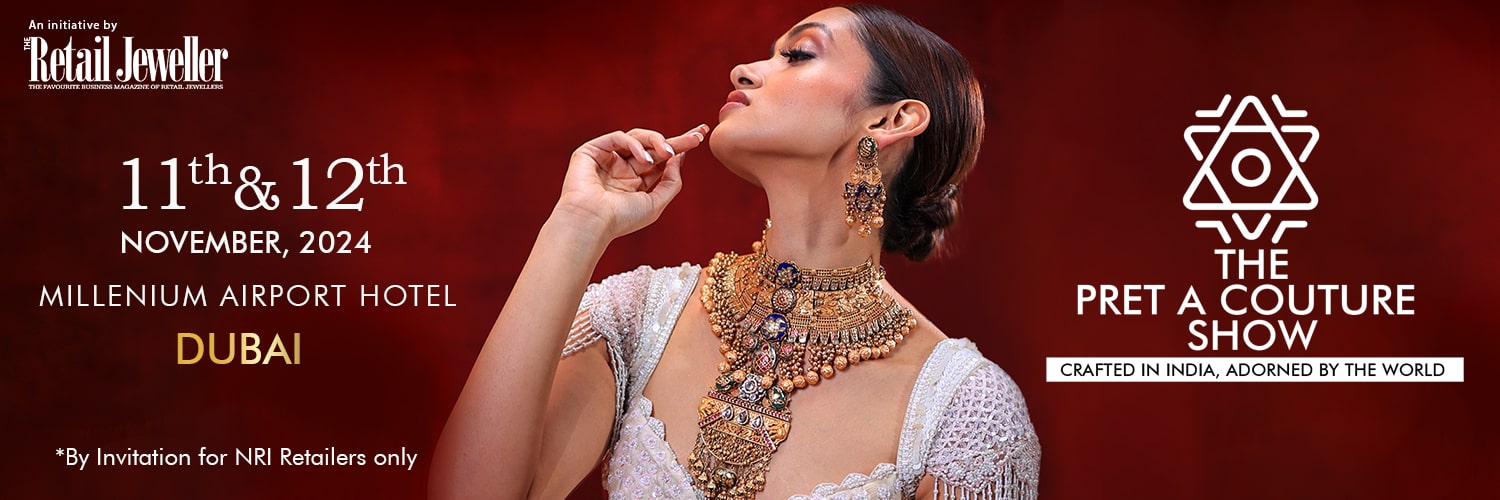Cover Feature
Cross-category retailing
Second-generation jeweller Nakshatra Mehta has come a long way. From a small shop at Zaveri Bazaar he now runs a one-stop bridal luxury couture jewellery store. In the fifth session of the Retail Jeweller India Forum 2017, he laid out the novel strategy he applied when he joined the family business, Mehta Emporium, and explained how it increased profitability.
Step one was a 30 per cent reduction in inventory, which increased both profit and turnover. “The sales staff would routinely take lots of boxes out of the strongroom, and put them back in at end of day,” said Mehta, describing how he spotted this opportunity. “When I asked, I learned that these were goods that no customer ever bought. A quick valuation showed that they comprised as much as 30 per cent of the total inventory. This was pure dead stock.”
After having the dead stock valued, Mehta decided to liquidate it and use the freed-up capital to create a new line of high-end designs. This was a first for his firm.
“We invested in setting up our own design team,” he said. “We stopped buying from our vendors the standard designs that they created. Instead we gave them exclusive designs from our own team to manufacture. This helped us get the designs that we knew our customers would like. To my surprise, our business grew by 45 per cent after this exercise.”
Simple calculation, he explained, told him that “earlier, for an investment of Rs100, we got a sale of Rs100. Having reduced this by 30 per cent we were still getting a sale of Rs100. On top of this, the new high-end line was yielding an incremental sale of Rs45.” In effect, sales had increased to Rs145.
“We found that a lot of customers who walked in to the store felt an impulsive urge to buy our unique new designs, as they had not seen them anywhere else. Over time, we acquired a number of new customers through reference.”
Contrary to popular belief, Mehta explained, consumers do not prefer a very large and varied inventory. “Our customers started appreciating the smaller assortments to choose from,” he said. Less products meant being able to impress his clients with fewer and better pieces. Mehta was quick to pivot accordingly: “We shifted our focus from quantity to quality in terms of design. We became more aware and sensitive to current trends and changing client tastes. This increased the acceptability of our designs to our elite clients.”
There was a direct effect on his employees. “Our staff was now motivated, as they had to deal with a smaller number of products. They gained the confidence that even with fewer products they could get higher sales. As we kept evolving the concept of ‘less is more’ in our own practice, we realised that we were making more out of less!”
Not long into this exciting turnaround, Mehta got the opportunity to expand his business onto the second floor of the same building. “At first I saw expansion as simply extending the store to another floor — more of the same! But I began to see it as an opportunity to create a new niche.”
After analysing his customer profile and buying trends, Mehta understood that “the main occasion for buying was weddings, and the main buyer the modern bride.” He had also observed that “The mother or mother-in-law is no longer the decision-maker in jewellery. The family is no longer our main client. It is the bride who is now the key decision-maker.”
As Mehta described her, the new-age bride is “Confident, fashion-savvy and looking for something rare and exclusive.” Having both sets of parents and the modern bride in agreement even on which jeweller to patronise, he grasped, is becoming more and more difficult. This suited him just fine. “We realised that our ancestral goodwill would bring in the parents, and our new concept would attract young brides.”
Last but not least, this innovative young businessman had noticed that wedding shopping, which in the past took a family months to complete, now had to be completed in weeks if not days. This told him that “Brides need a one-stop destination for weddings. Our new brand, Rare Heritage by Mehta Emporium, is about providing everything that a bride might want, under one roof.” Accordingly, Mehta brought in “an exclusive line of bridalwear; bejewelled accessories including clutches, purses, wallets and stationery; silverware; and jewellery.”
Thus updated and perfected, Rare Heritage by Mehta Emporium is the talk of the town, drawing clients from far and wide as “a specialty store that not only offers exclusive bridal jewellery but extends the idea of jewels into all must-haves for a trousseau, making it an exclusive as well as a unique experience for brides.”

 Wide Angle2 months ago
Wide Angle2 months agoIndia has overtaken China to become second largest diamond market: De Beers CEO Al Cook

 Daily News2 months ago
Daily News2 months agoLimelight Lab Grown Diamonds secures $ 11 million in funding to fuel its retail growth

 Daily News2 months ago
Daily News2 months agoIndia is largest consumer of gold jewellery in 2024, surpassing China: WGC report

 Exclusive1 month ago
Exclusive1 month agoWith Rs 100 cr revenue in 9 months of FY25, Gargi by PNGS is in aggressive expansion mode
























